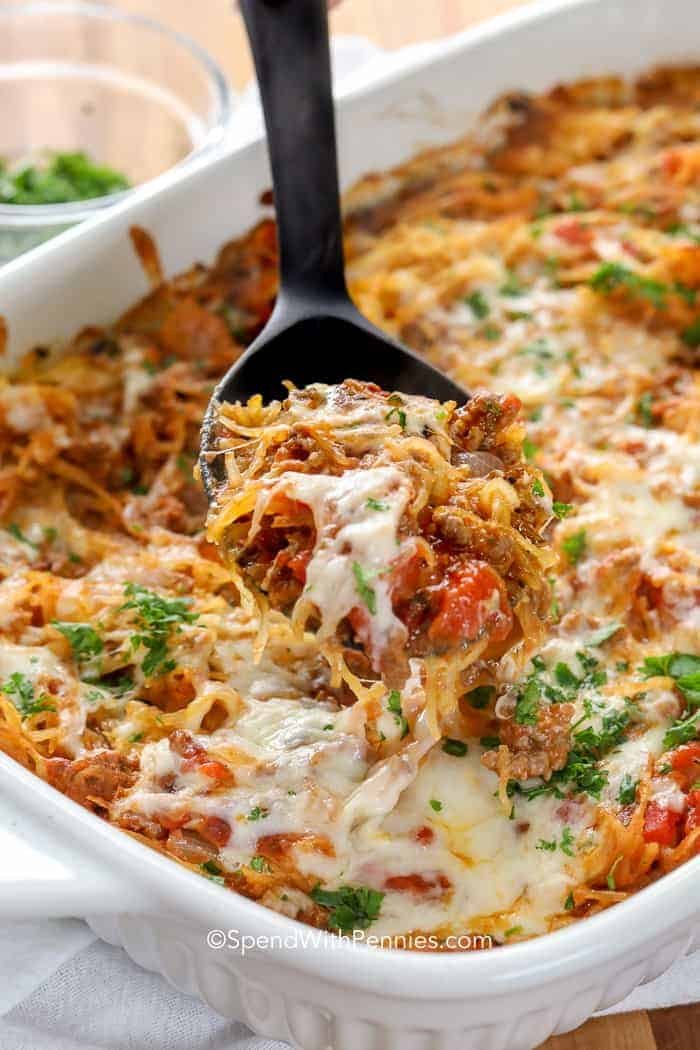To prevent watery squash casserole, salt and sauté the squash to remove moisture before baking. Cream cheese and sour cream add richness and tang to the filling.
Are you looking for a delicious and healthy casserole recipe? Spaghetti squash casserole is a savory and satisfying dish that combines the natural sweetness of spaghetti squash with creamy and tangy fillings. This versatile dish can be customized with various ingredients to suit your taste preferences.
Not only is it a great way to incorporate more vegetables into your diet, but it’s also a crowd-pleaser that can be enjoyed as a main course or a side dish. Whether you’re following a low-carb, keto, or gluten-free diet, this spaghetti squash casserole is a nutritious and comforting option that’s easy to make and perfect for any occasion.

Introduction To Spaghetti Squash Casserole
Spaghetti squash casserole is a delightful dish that brings together the unique flavors and textures of spaghetti squash with a medley of other delicious ingredients. This versatile and nutritious squash variety provides a wonderful base for creating a comforting and wholesome casserole that’s perfect for any occasion.
Brief Overview Of The Popularity Of Spaghetti Squash
Spaghetti squash has garnered a substantial following in the health and wellness community due to its low-carb and gluten-free nature. As more people seek out alternative ingredients for traditional pasta dishes, spaghetti squash has gained traction for its ability to mimic the appearance of spaghetti noodles. It’s a popular choice for anyone looking to incorporate more vegetables into their diet while still enjoying the familiar texture of spaghetti.
Nutritional Benefits Of Spaghetti Squash
Spaghetti squash is a nutritional powerhouse, packed with essential vitamins and minerals. Here are some of the nutritional benefits of this versatile ingredient:
- Low in calories and carbohydrates
- High in fiber, it promotes digestive health
- Rich in Vitamin C and Vitamin A, which support a healthy immune system and vision
- Contains B vitamins that aid in energy production
Preparing Spaghetti Squash For Casserole
Before creating a delicious spaghetti squash casserole, it’s essential to prepare the squash properly. The right preparation ensures that the casserole turns out flavorful and perfectly textured. Here are the crucial steps for preparing spaghetti squash for your casserole:
Slicing And Removing Seeds
To start, carefully slice the spaghetti squash in half lengthwise using a sharp knife. Then, scoop out the seeds and stringy bits using a spoon. Place the halves, cut side down, on a baking sheet and roast in the oven until tender. Alternatively, you can microwave the squash halves for a faster cooking process.
Alternative Methods Of Cooking Spaghetti Squash
If roasting or microwaving the squash doesn’t align with your schedule, consider using other cooking methods, such as steaming or pressure cooking. These methods can also yield tender and flavorful spaghetti squash for your casserole.
Avoiding Excess Moisture In Squash
To prevent your spaghetti squash casserole from becoming watery, it’s essential to eliminate excess moisture from the cooked squash. Salting and sautéing the squash before baking is an effective technique to remove the excess moisture and ensure a perfectly textured casserole. Additionally, refrain from adding too much oil or salt while preparing the squash, as this can contribute to excess moisture.
Ingredients For Spaghetti Squash Casserole
Spaghetti squash casserole is a delightful dish that brings together the earthy flavors of roasted spaghetti squash with a medley of other ingredients. The unique texture of the squash provides a healthy and nutritious base for this comforting casserole. Here are the essential ingredients needed for preparing a delicious spaghetti squash casserole.
List Of Essential Ingredients
- Spaghetti squash: 1 medium-sized
- Ground meat: 1 lb (can use beef, turkey, or plant-based substitute for vegetarian or vegan option)
- Onion: 1, diced
- Garlic: 2 cloves, minced
- Canned diced tomatoes: 1 can (14 oz)
- Italian seasoning: 1 tablespoon
- Shredded cheese: 1 cup (mozzarella, cheddar, or dairy-free alternative)
- Seasonings: Salt and pepper to taste
- Olive oil: 2 tablespoons
Possible Variations For Dietary Preferences
For those with dietary preferences and restrictions, several variations can be made to accommodate different needs:
- Vegetarian/Vegan: Replace ground meat with plant-based protein such as lentils, chickpeas, or textured vegetable protein (TVP).
- Gluten-free: Ensure all ingredients, including seasonings and canned tomatoes, are certified gluten-free to make the dish suitable for individuals with gluten intolerance.
- Dairy-free: Use dairy-free cheese alternatives or omit the cheese altogether for a lactose-free version of the casserole.
Nutritious Substitutions
Incorporating nutritious substitutions can enhance the health benefits of the spaghetti squash casserole.
- Lean protein: Opt for lean ground turkey or chicken for a lighter alternative to beef.
- Add vegetables: Include diced bell peppers, spinach, or zucchini for added nutrition and texture.
- Whole grains: Mix cooked quinoa or brown rice with the casserole filling for a nutrient-rich boost.
Cooking Process For Spaghetti Squash Casserole
Spaghetti squash casserole is a delightful, healthy dish that’s perfect for a satisfying meal. This nutritious alternative to traditional pasta is not only delicious but also easy to make. The cooking process for spaghetti squash casserole involves preparing and layering the ingredients to create a flavorful and wholesome dish that the whole family will enjoy.
Instructions For Baking Or Roasting The Squash
To start, the first step in making a spaghetti squash casserole is preparing the squash. The squash can be roasted in an oven or baked, both methods resulting in tender and flavorful strands that resemble spaghetti. Here is the method for baking or roasting the squash:
- Preheat the oven to 400°F.
- Using a sharp knife, carefully cut the spaghetti squash in half lengthwise.
- Scoop out the seeds and the stringy bits from the center of the squash using a spoon.
- Place the halves, cut side down, on a baking sheet lined with parchment paper.
- Bake the squash for 40–50 minutes, or until the flesh is tender.
- Once cooked, use a fork to scrape out the spaghetti-like strands of the squash into a separate bowl.
Layering The Casserole With Additional Ingredients
After the spaghetti squash is prepared, it’s time to layer it with additional ingredients to create a delicious casserole. Here’s how to do it:
- Prepare the preferred casserole dish by lightly greasing the bottom and sides with olive oil.
- Spread a layer of marinara sauce or your favorite tomato-based sauce on the bottom of the dish.
- Add a layer of the cooked spaghetti squash on top of the sauce.
- Sprinkle a generous amount of shredded cheese or a dairy-free alternative over the squash layer.
- Add another layer of sauce, followed by the rest of the spaghetti squash.
- Top the casserole with another layer of sauce and a final sprinkling of cheese.
Baking Time And Temperature
After the layers are arranged, the casserole is ready to be baked. Here are the final steps:
- Preheat the oven to 375°F.
- Cover the casserole dish with aluminum foil and bake for 25–30 minutes.
- Remove the foil and continue to bake for an additional 10–15 minutes, or until the cheese is bubbly and lightly golden brown.
- Before serving, allow the casserole to cool for a few minutes to set.
Serving And Enjoying Spaghetti Squash Casserole
Spaghetti squash casserole is a delicious and versatile dish that is perfect for entertaining guests or enjoying a cozy family dinner. However, serving and enjoying this delectable dish can be just as important as the cooking process. Here are some tips and ideas for presenting, pairing, and creatively using leftovers of the spaghetti squash casserole.
Presentation Tips For Serving The Casserole
When serving spaghetti squash casserole, the presentation can elevate the dining experience. Consider arranging the casserole in an elegant baking dish and sprinkling it with fresh herbs such as parsley or basil for a pop of color. You can also add a sprinkle of grated Parmesan cheese or breadcrumbs on top for a delicious finishing touch.
Pairing Suggestions For Side Dishes Or Accompaniments
To complement the flavors of the spaghetti squash casserole, consider pairing it with a crisp green salad tossed in a light vinaigrette dressing. For a heartier option, garlic bread or dinner rolls can be a delightful addition. Additionally, a side of roasted vegetables, such as asparagus or Brussels sprouts, can add texture and variety to the meal.
Creative Leftover Ideas For The Casserole
Leftover spaghetti squash casserole can be repurposed in creative ways to make new and exciting dishes. Consider using the leftovers as a filling for stuffed bell peppers or as a topping for a homemade pizza. Another option is to mix the leftover casserole with scrambled eggs for a flavorful breakfast hash the next morning.
Frequently Asked Questions For Spaghetti Squash Casserole
How Do You Keep Squash Casserole From Getting Watery?
To prevent squash casserole from getting watery, salt and sauté the squash before baking to remove excess moisture. Cream cheese and sour cream also help prevent sogginess. Avoid salting too heavily or adding too much oil before roasting spaghetti squash.
Cut and roast it at a lower temperature for better results.
Does Spaghetti Squash Get Soggy?
When cooked correctly, spaghetti squash should not get soggy. Avoid overstepping or adding too much oil before baking.
How Do You Keep Spaghetti Squash From Getting Watery?
To prevent spaghetti squash from getting watery, salt and sauté it before cooking to remove excess moisture. Avoid over-salting and using too much oil. Additionally, cut the squash in half, remove the seeds, drizzle with olive oil, and sprinkle with salt and pepper before cooking.
How Do You Not Overcook Spaghetti Squash?
To avoid overcooking spaghetti squash, roast it cut side down at a lower temperature for a little longer. Cooking at a high temperature can make it mushy on the outside and firm on the inside.
Conclusion
Incorporating spaghetti squash casserole into your menu will not only add variety but also provide a healthy alternative. With its rich, tangy filling and unique flavor, this dish is sure to satisfy. Plus, the helpful tips on avoiding a watery outcome ensure a delicious and successful cooking experience!

Hi, I’m Esrat, and I’m so glad that you found me here at Happy Food Kitchen! I started Happy Food Kitchen in 2023 to have a creative, right-brained outlet to balance my very left-brained career in genetics.






